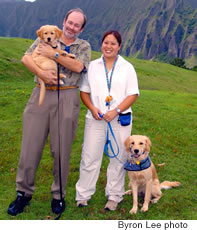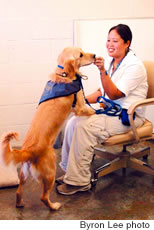The Therapist’s Best Friend
The occupational therapy team at the Hawaii State Hospital has hired two furry recruits and their handler, Tiffany Hamaguchi, OTD, as part of a groundbreaking new program

Hamaguchi works on ‘leave it’ (not to be distracted
by food) with Zoe — those are doggie treats on
Zoe’s paws
Meet Zoe, one of the latest recruits at the Hawaii State Hospital. As part of the occupational therapy team, Zoe is a little cuter (sorry, folks) and a little hairier than your usual hospital employee. She’s a 14-month-old golden retriever, and she’s part of a groundbreaking new program for the Kaneohe campus.
Zoe’s two-legged handler is occupational therapist Tiffany Hamaguchi. She came to the hospital in August, bringing the animal assisted therapy program with her. The program works in a number of different ways, but basically the dogs are an engaging tool to help patients rehabilitate and learn life skills.
“It’s powerful,” Hamaguchi says of the canine touch.
The program has just started, but it is already growing. Just three weeks ago, Zoe was joined by Zane. He’s a fluffy 2-month-old male pup who is exceptionally high on the cute quotient. Hamaguchi, an Iolani grad, hopes the pair are the beginning of a happy breeding effort.
Everyone knows about the power of pet therapy - how interaction with animals can lower blood pressure, heart rate, respiration and stress levels. But Hamaguchi’s program is a clinical model that goes way beyond that.

Hawaii State Hospital
rehabilitation director Kim Meyer,
Ph.D. holding Zane while occupational
therapist Tiffany Hamaguchi holds Zoe
Animal assisted therapy, which was developed by a nun in Washington State in 1981, is becoming increasingly popular. There are 21 prison-based dog-training programs across the nation, but Hamaguchi believes the state hospital is the first forensic psychiatric hospital with such a program.
Zoe herself was raised in an Indiana prison by Hope, an inmate. Hamaguchi worked at the prison for her doctoral internship and was given Zoe as a gift.
Now Zoe works a five-day week at the state hospital, making the daily commute from Hamaguchi’s Mililani home. At work she wears her “uniform,” a training head halter and vest, complete with her own staff ID tag that bears her serenely smiling mug shot.
She spends her days completing her training with Hamaguchi and working with the patients. Because few people are immune to the dogs’ charms, they are a great catalyst for drawing patients out and getting them engaged in different activities. Zoe can spark a smile or eye contact from patients for whom such communication can be extremely difficult, Hamaguchi says.
One of the good things about the animals is that they are non-judgmental, says hospital rehabilitation director Kim Meyer.
“They accept you for who you are,” he says. “If you treat them well, they don’t care what you did 15 years ago or 20 years ago.”
And the program is a great opportunity for patients to develop meaningful skills and relationships, Meyer adds.

Hamaguchi is starting Zane
on the basics
In one popular exercise aimed at building social skills, two people with a dog tied to them are asked to build a tower out of marshmallows and spaghetti (uncooked) without speaking. The resulting tangled challenge is an effective and fun way to develop eye contact, an awareness of body language and stress management skills, Hamaguchi says.
There’s also the Walk a Hound, Lose a Pound program. Many patients have weight problems because of their medications, so taking Zoe for a walk around the grounds is good exercise motivation, Hamaguchi says.
Zoe also is helping to teach work skills. A rigorous pet care technician class teaches animal behavior management and handling skills that could lead to employment at a groomer’s or veterinary clinic. There is also a grooming class, where patients learn to bathe a dog, clip their nails, clean their teeth and even give them a massage.

The ‘lap’ command gets Zoe
to reach closer
Hamaguchi’s real passion for the future is to have hospital patients train a growing cadre of animals as service dogs for people with physical disabilities such as spinal cord injury, spina bifida or multiple sclerosis. Highly trained service dogs help these people navigate life, whether it be opening doors, getting the milk from the fridge, the cell phone off the floor or providing balance for the person to stand.
Currently there is a two-year wait in Hawaii for service dogs, Hamaguchi says, so the training program would fill a big need as well as providing meaningful work for patients.
It’s still early days, but the program is turning into a winning situation all around. Even the staff is enjoying the new recruits. Occupational therapy aide Bill Keegan, who shares his office with Hamaguchi and Zoe and Zane (and their training tools and toys and bones and treats), says he’s never had so many visitors. Everyone from security guards to psychiatrists has beaten a path to their door to pat a head or tickle a fluffy puppy tummy.
“Some people come down when they’ve had a bad day just to sit with them and pet them,” Hamaguchi says. “It’s been therapeutic for everyone, I think.”
Page 1 of 1 pages for this story
E-mail this story | Print this page | Comments (0) | Archive | RSS
Most Recent Comment(s):








